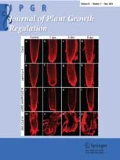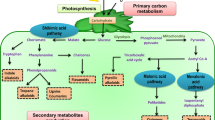Abstract
The arbuscular mycorrhizal symbiosis can alleviate salt stress in plants by altering strigolactone levels in the host plant. The aim of this study was to investigate the mechanism by which strigolactones enhance salt stress tolerance in arbuscular mycorrhizal Sesbania cannabina seedlings. Strigolactone levels, as determined by means of germination bioassay, gradually increased with treatment time of NaCl applied. Inhibition of NADPH oxidase activity and chemical scavenging of H2O2 significantly reduced strigolactone-induced salt tolerance and decreased strigolactone levels. The H2O2-induced strigolactone accumulation was accompanied by increased tolerance to salt stress. These results strongly indicated that elevated H2O2 concentration resulting from enhanced NADPH oxidase activity regulated strigolactone-induced salt stress tolerance in arbuscular mycorrhizal S. cannabina seedlings.




Similar content being viewed by others
References
Akiyama K, Matsuzaki K, Hayashi H (2005) Plant sesquiterpenes induce hyphal branching in arbuscular mycorrhizal fungi. Nature 435:824–827
Andreo-Jiménez B, Ruyter-Spira C, Bouwmeester H López-Ráez JA (2015) Ecological relevance of strigolactones in nutrient uptake and other abiotic stresses, and in plant-microbe interactions below-ground. Plant Soil 394:1–19
Aroca R, Ruiz-Lozano JM, Zamarreño AM, Paz JA, García-Mina JM, Pozo MJ, López-Ráez JA (2013) Arbuscular mycorrhizal symbiosis influences strigolactone production under salinity and alleviates salt stress in lettuce plants. J Plant Physiol 170:47–55
Badri DV, Weir TL, van der Lelie D, Vivanco JM (2009) Rhizosphere chemical dialogues: plant–microbe interactions. Curr Opin Biotechnol 20:642–650
Brennan T, Frenkel C (1977) Involvement of hydrogen peroxide in the regulation of senecence in pear. Plant Physiol 59:411–416
Bu Q, Lv T, Shen H, Luong P, Wang J, Wang Z, Huang Z, Xiao L, Engineer C, Kim TH, Schroeder JI, Huq E (2014) Regulation of drought tolerance by the F-box protein MAX2 in Arabidopsis. Plant Physiol 164:424–439
Cheeseman JM (2007) Hydrogen peroxide and plant stress: a challenging relationship. Plant Stress 1:4–15
Cuyper CD, Fromentin J, Yocgo RE, Keyser AD, Guillotin B, Kunert K, Boyer FD, Goormachtig S (2014) From lateral root density to nodule number, the strigolactone analogue GR24 shapes the root architecture of Medicago truncatula. J Exp Bot 66:137–146
De Almeida AMM, Gomes VFF, Mendes PF, de Lacerda CF, Freitas ED (2016) Influence of salinity on the development of the banana colonized by arbuscular mycorrhizal fungi. Rev Cienc Agronomica 47:421–428
Garg N, Bhandari P (2012) Influence of cadmium stress and arbuscular mycorrhizal fungi on nodule senescence in Cajanus cajan (L.) Millsp. Int J Phytoremediation 14:62–74
Gechev TS, Van Breusegem F, Stone JM, Denev I, Laloi C (2006) Reactive oxygen species as signals that modulate plant stress responses and programmed cell death. Bioessays 28:1091–1101
Giovannetti M, Mosse B (1980) An evaluation of techniques for measuring vesicular–arbuscular mycorrhizal infection in roots. New Phytol 84:489–500
Gomez- Roldan V, Fermas S, Philip BB et al (2008) Strigolactone inhibition of shoot branching. Nature 455:189–194
Ha C V, Leyva-Gonzalez MA, Osakabe Y, Tran UT, Nishiyama R, Watanabe Y, Tanaka M, Seki M, Yamaguchi S, Dong NV, Yamaguchi-Shinozaki K, Shinozaki K, Herrera-Estrella L, Tran LSP (2014) Positive regulatory role of strigolactone in plant responses to drought and salt stress. Proc Natl Acad Sci 111:851–856
Hajiboland R, Aliasgharzadeh N, Laiegh SF, Poschenrieder C (2010) Colonization with arbuscular mycorrhizal fungi improves salinity tolerance of tomato (Solanum lycopersicum L.) plants. Plant Soil 331:313–327
Ito S, Umehara M, Hanada A, Kitahata N, Hayase H, Yamaguchi S, et al (2011) Effects of triazole derivatives on strigolactone levels and growth retardation in rice. PLoS ONE doi:10.1371/journal.pone0021723
Kwak JM, Mori IC, Pei ZM, Leonhardt N, Torres MA, Dangl JL (2003) NADPH oxidase AtrbohD and AtrbohF genes function in ROS-dependent ABA signaling in Arabidopsis. EMBO J 22:2623–2633
Liu J, He H, Vitali M, Visentin I, Charnikhova T, Haider I, Schubert A, Ruyter-Spira C, Bouwmeester HJ, Lovisolo C, Cardinale F (2015) Osmotic stress represses strigolactone biosynthesis in Lotus japonicus roots: exploring the interaction between strigolactones and ABA under abiotic stress. Planta 241:1435–1451
López-Ráez JA, Charnikhova T, Gómez-Roldán V, Matusova R, Kohlen W, De Vos R, Verstappen F, Puech-Pages V, Bécard G, Mulder P, Bouwmeester H (2008) Tomato strigolactones are derived from carotenoids and their biosynthesis is promoted by phosphate starvation. New Phytol 178:863–874
López-Ráez JA, Pozo MJ, García-Garrido JM (2011) Strigolactones: a cry for help in the rhizosphere. Botany 89:513–522
Manivannan P, Jaleel CA, Sankar B, Somasundaram R, Mural P V, Sridharan R, Panneerselvam R (2007) Salt stress mitigation by calicium chloride in Vigna radiata (L.) Wilczek. Acta Biol Crac Ser Bot 49:105–109.
Neill S, Desikan R, Hancock J (2002) Hydrogen peroxide signalling. Curr Opin Plant Biol 5:388–395
Phillips J M, Hayman D S (1970) Improved procedures for clearing roots and staining parasitic and vesicular–arbuscular mycorrhizal fungi for rapid assessment of infection. Trans Brit Mycol Soc 55:158–161
Pozo MJ, López-Ráez JA, Azcón C, García-Garrido JM (2015) Phytohormones as integrators of environmental signals in the regulation of mycorrhizal symbioses. New Phytol 205:1431–1436
Ren CG, Dai CC (2012) Jasmonic acid is involved in the signaling pathway for fungal endophyte-induced volatile oil accumulation of Atractylodes lancea plantlets. Plant Biol 12:128
Ren CG, Bai YJ, Kong CC, Bian B, Xie ZH (2016) Synergistic interactions between salt-tolerant rhizobia and arbuscular mycorrhizal fungi on salinity tolerance of Sesbania cannabina plant. J Plant growth Regul. doi:10.1007/s00344-016-9607-0
Ruiz-Lozano JM, Aroca R, Zamarreño ÁM, Molina S, Andreo-Jiménez B, Porcel R, García-Mina JM, Ruyter-Spira C, López-Ráez JA (2016) Arbuscular mycorrhizal symbiosis induces strigolactone biosynthesis under drought and improves drought tolerance in lettuce and tomato. Plant Cell Environ 39:441–452
Ruyter-Spira C, Al-Babili S, van der Krol S, Bouwmeester H (2013) The biology of strigolactones. Trends Plant Sci 18:72–83
Smith SE, Read DJ (2008) Mycorrhizal symbiosis. Academic Press, London.
Torres MA, Dangl JL (2005) Functions of the respiratory burst oxidase in biotic interactions, abiotic stress and development. Curr Opin Plant Biol 8:397–403
Walter MH, Strack D (2011) Carotenoids and their cleavage products: biosynthesis and functions. Nat Prod Rep 28:663–692
Xia XJ, Wang YJ, Zhou YH, Tao Y, Mao WH, Shi K, Asami T, Chen ZX, Yu JQ (2009) Reactive oxygen species are involved in brassinosteroid-induced stress tolerance in cucumber. Plant Physiol 150:801–814
Xia XJ, Zhou YH, Ding J, Shi K, Asami T, Chen ZX, Yu JQ (2011) Induction of systemic stress tolerance by brassinosteroid in Cucumis sativus. New Phytol 191:706–720
Xie XN, Yoneyama K, Yoneyama K (2010) The strigolactone story. Annu Rev Phytopathol 48:93–117
Xiong L, Schumaker K S, Zhu J K (2002) Cell signaling during cold, drought, and salt stress. Plant Cell 14(suppl 1):S165–S183
Yoneyama K, Xie X, Sekimoto H, Takeuchi Y, Ogasawara S, Akiyama K, Hayashi H (2008) Strigolactones, host recognition signals for root parasitic plants and arbuscular mycorrhizal fungi, from Fabaceae plants. New Phytol 179:484–494
Yoneyama K, Xie X, Yoneyama K, Takeuchi Y (2009) Strigolactones: structures and biological activities. Pest Manage Sci 65:467–470
Zhou J, Wang J, Li X, Xia XJ, Zhou YH, Shi K, Chen Z, Yu JQ (2014) H2O2 mediates the crosstalk of brassinosteroid and abscisic acid in tomato responses to heat and oxidative stresses. J Exp Bot 65:4371–4383
Acknowledgements
This work was financed by the Key Research Program of the Chinese Academy of Sciences (Grant NO. KZZD-EW-14), the National Natural Science Foundation of China (31601238, 31370108, 31570063, and 31201266), One Hundred-Talent Plan of Chinese Academy of Sciences (CAS), Yantai Key Project of Research and Development Plan (2016ZH074). Yantai Science and Technology Project (2013JH021). The National “948” Project of China (#2014-Z39), Shanxi Province Key Project of Coal-based Science and Technology (#FT-2014-01). We thank Professors Hui Lin and Bing Zhao for kindly providing arbuscular mycorrhiza strains. We also thank Professor Yong-Qing Ma (North West Agriculture and Forestry University) for supplying the seeds of Phelipanche ramose.
Author information
Authors and Affiliations
Corresponding authors
Additional information
Cun-Cui Kong, Cheng-Gang Ren have contributed equally to this study.
Electronic supplementary material
Below is the link to the electronic supplementary material.
Rights and permissions
About this article
Cite this article
Kong, CC., Ren, CG., Li, RZ. et al. Hydrogen Peroxide and Strigolactones Signaling Are Involved in Alleviation of Salt Stress Induced by Arbuscular Mycorrhizal Fungus in Sesbania cannabina Seedlings. J Plant Growth Regul 36, 734–742 (2017). https://doi.org/10.1007/s00344-017-9675-9
Received:
Accepted:
Published:
Issue Date:
DOI: https://doi.org/10.1007/s00344-017-9675-9




